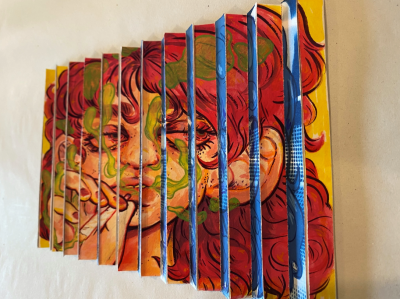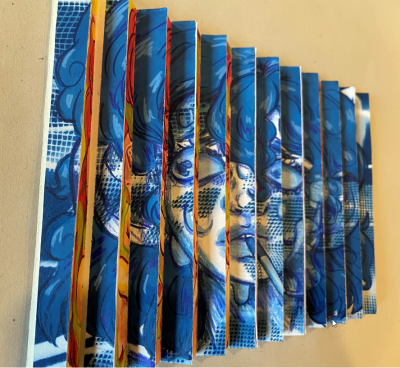Western's Art 306 Class Contributes to COVID-Themed Exhibition in Vancouver BC
Western’s Art 306 class, led by Professor of Art Cara Jaye, have submitted their class work to the Penticton Art Gallery in Vancouver, British Columbia, and joined the international group of artists participating in the gallery’s “You Are Not Alone” COVID-themed exhibition.
“With the onset of the COVID-19 pandemic and the resulting imposition of self-isolation, the Penticton Art Gallery, in partnership with the Syria.art Association, invited artists from across the globe to participate in ‘You Are Not Alone,’” Jaye said. “Like a message in a bottle, we sent out a call to artists working in all media to submit works which would serve as a testament to our resiliency, creativity, and collective humanity in face of these extraordinary times.”
Art 306, Mixed Media on Paper is, according to Jaye, an upper-level course where the students explore using a variety of media and surfaces in two-dimensional formats such as collage, gouache, watercolor, pens, inks, and paint markers.
“The class prompts are thematic in nature, and the students respond to the prompts in a variety of media. There is no one correct way to do something in art, and when the students are experimenting with a combination of different materials and surfaces (various papers, panels, wood etc.) they might discover something individual and unique,” she said.
For the final project of the quarter last spring, Jaye’s students were tasked with making three unique pieces that responded to this time in their lives. Students kept one, sent one to a classmate and sent another to the exhibition. Jaye had all of the projects sent to her home and packaged them up with her own contribution, then sent everything to the gallery.
The theme for the class prompt was about the COVID Pandemic, and which Jaye titled “Going Viral.”
“I thought it would be good to make work that addressed the things we were all living through. The Penticton exhibition was titled ‘You are Not Alone.’ Their theme was connected to the idea that all the participants could come together in this mail art exhibition, even if we were not together in person,” she said.
The project prompt encouraged students to address their experiences with quarantine. Isolation, social distancing and the anxiety and fear associated with both were all listed as possible jumping off points.
“One of the requirements in the prompt was that the students use the cyanotype process in combination with other materials. The cyanotype is an early photographic process that is printed on a receptive paper, similar to watercolor paper, that the students could go back into and add other materials on top,” Jaye said.
I feel proud of all of them, and excited for them too.
“It was discovered in England in 1842, and one of the earliest users was Anna Atkins, who made botanical images. She is considered the first female photographer,” Jaye said.
“You can make images by placing objects on the light sensitive paper, or you can use a negative, but the image is going to be actual size, not enlarged as they would be in a darkroom situation. They are exposed in sunlight or with a UV lamp, so it is possible to do it at home with little equipment, especially with the pre-coated paper that I had sent to the students to use,” she said.
Each student was sent a cyanotype kit in order to complete their projects from home.
“The traditional cyanotype is made from two chemical components solutions that are mixed. They are ferric ammonium citrate and potassium ferricyanide. When cyanotype is taught in a regular class that meets on campus, I would teach them this method and we would use the darkroom in the Fine Arts building to coat our paper and then either expose in the sun or with the UV light box. However, due to COVID, we needed something simpler that the students could do on their own at home,” Jaye said.
“There are several commercial kits available and they can vary. I chose to send them all individual packages of pre-coated papers that they could use easily on their own at home. No brush was required, they just needed to expose the paper in the sun, and wash it out in a sink at home,” she said.
Jaye said that is been very gratifying to see the names of her students listed among all the artists who participated in the exhibition, especially next to well-known artists like Damian Hirst and Peter Halley. “You Are Not Alone” will be archived by the gallery but has also been made into a permanent online exhibition thanks to the efforts of Berlin-based curator, Humam Alsalim.
“The class did some phenomenal pieces, and I feel like their work and individual voices added so much to the exhibition. This is also a great opportunity for the students as the show is slated to travel to both Berlin and France in 2021, and the works have been digitally captured as a permanent online exhibition. I feel proud of all of them, and excited for them too,” she said.

